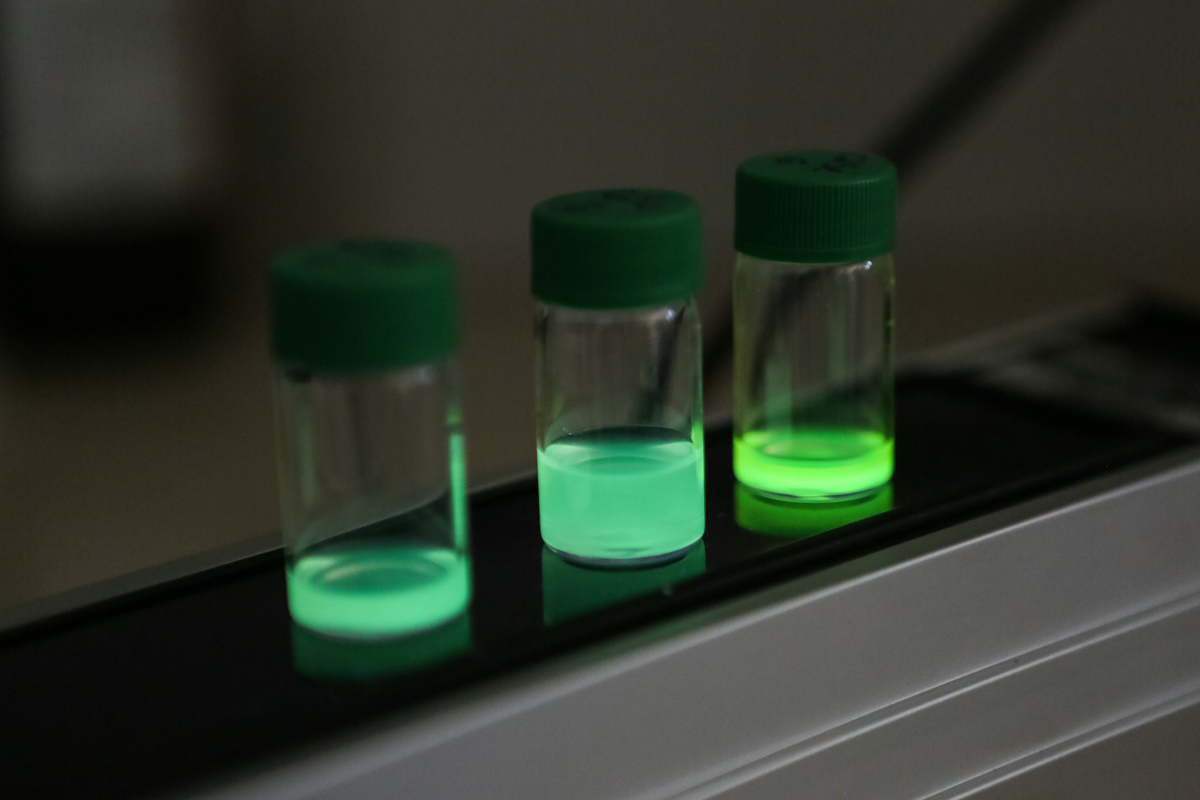Fluorescent quantum dot ink on guard of secure printing: SPbU students

The students who take part in the competition “SPbU Start-Up— 2018” have come with an idea how to secure your documents: Quantum Break is developing fluorescent quantum dot ink.
The fluorescent quantum dot ink is on guard of secure printing as these documents are hardly possible to forge since the ink is composed in such a way as to create a unique combination of colours that is visible under the ultraviolet rays.
Particles of different colours
Any passport, property document, labour agreement must be authorized by attaching your signature that is your name written in a distinctive way as a form of identification in authorizing a document. Such forms of identification are typical to any company too – few or no company has no seal. The bad news is that any signature or seal can be forged and therefore your rights or your property can be owned by the third parties. The quantum dot ink is on guard of your security. This is what SPbU students are developing.
The quantum dots are nanoparticles that emit light that can be of various colours (blue, red, green, yellow – any!) depending on the size, composition, or time of synthesis. It is only visible under the ultraviolet light, and their fluorescent properties are well preserved unless the nanoparticles are mechanically destroyed.
The leader of the team, SPbU aspirantura student Andrei Mitrofanov
Today, the quantum dots are taking over our TVs as they are widely used in displays. The spectrum range of the quantum dots is rather smooth, and quantum dot TV, unlike the previous generation of TVs, provides vivid blue, says the researcher.
Security and brightness
“We don’t focus on TV display market. Rather we are creating quantum dot ink, — says Andrei Mitrofanov. — The ink can secure paper from document forgery and help create unique printed materials like fluorescent flyers or brochures. The technology, as an alternative to seals and signatures and additional document security, must be of interest to business community as well. Moreover, the ink can be used in producing the lottery and concert tickets that are also vulnerable to forgery”.
The quantum dots are synthesized by using zinc chalcogenides and cadmium that offer the widest gamut possible to produce millions of visible colours. Producing quantum dots takes about two hours, and all you need to convert the coded information is a pocketsize UV torch.
Today, we are working on incorporating the quantum dots into inks and produce homogeneous mixture to deliver superior quality print with laser-sharp texts.
The leader of team, aspirantura student Andrei Mitrofanov
“As a result we are planning to have a pen or a cartridge that can be filled in with the quantum dot ink. Another application is a specially-designed set to fill in a cartridge with our ink. What we are driving at is to make it user-friendly and intuitively clear”— said Andrei Mitrofanov.
Trust to paper
As the leader of the team says, there are other applications for the quantum dots as well. As the nanoparticles can accumulate a wide spectrum of sun light, they are effectively used in solar batteries. Another area is medicine where the quantum dots can serve as a contrast medium that can be “taught” to identify the cells.
The team that is headed by Andrei Mitrofanov also comprises a student in chemistry Polina Oleneva, students in physics Ilsur Sharapov and Maksim Katrushenko, and a student in economics Dmitrii Batchenko. They confess that they regularly hear that secure printing has no future as e-documents are gaining momentum. However they put forward a counter-argument: “E-documents are not wide spread so far, and people trust more in paper”.
“You can not stop evolution and we are heading towards the e-documents, — said the scientific supervisor of the team, SPbU Associate Professor and Candidate of Chemistry Artem Seliutin. — Still it is not a matter of another 5-10 years in Russia as there is much to be changed in a way how we work and interact. What is more important is that we should change the way how we think of e-documents. It takes some time. All these make me think that our project can be a success”.

